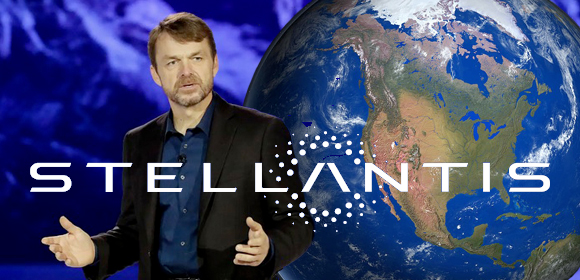FCA CEO Mike Manley to lead Americas operations for Stellantis – but where?

It was announced in a letter from Fiat Chrysler Automobile (FCA) chairman John Elkann to employees on December 11, 2020, that Mike Manley, CEO of FCA, will head up the Americas operations for the newly formed Stellantis — the merger of Groupe PSA and FCA.
In announcing the news, Elkann cited Manley’s leadership following the 2018 death of Sergio Marchionne, the chief executive who merged Fiat SpA and the former Chrysler Group, as well as Manley’s leadership throughout the coronavirus crisis and his prior experience heading up FCA’s most lucrative brands.
“Perhaps it should be no surprise that having led the profound transformation and exceptional development of the Jeep and Ram brands before becoming our CEO, Mike has taken the rough terrain of the past couple of years in his stride,” Elkann wrote. “We have been fortunate indeed to have him as our CEO.”

Current CEO of PSA, Carlos Tavares, will become CEO of Stellantis, once the deal is complete in early 2021. The French and Italian-American automakers are combining via a 50-50 stock split in a deal that would create the fourth-largest automaker in the world by sales volume.

Under the terms of the deal, PSA will name six people to the 11-member Stellantis board, while FCA will name five. Manley will not be on the board, but Tavares and Elkann will be. Manley had previously said he would remain with the automaker in an unspecified senior executive role.
Manley was appointed CEO of FCA in July 2018, days before the death of Marchionne in a Zurich hospital. Manley previously served as the automaker’s head of Jeep brand, head of Ram brand, and chief operating officer for the Asia Pacific region as well as executive vice president for international sales and global product planning operations. He joined what was then DaimlerChrysler AG in 2000 as director of network development in the United Kingdom.
As CEO of FCA, Manley originally pursued a merger with French automaker Renault SA that ultimately fell through amid recriminations of meddling by French government officials. The agreement with PSA was announced a year ago.
During his tenure as CEO of FCA, Manley has committed to major investments in Michigan, investing $1.6 billion USD in the new Mack Assembly Plant in Detroit, where it will build an unnamed new full-size Jeep SUV. The facility is the city’s first new assembly plant in nearly three decades. The adjacent Jefferson North Assembly Plant is also getting a $900 million USD update.
“One of the things we believe in as a very large global organization is the places where we invest in, where we have big facilities, that we should be in that community, and we should look like that community,” Manley told The Detroit News in a recent interview. “We want to be able to provide great employment for people in that community.”
Manley’s role in Stellantis poses an interesting question about Carlos Tavares’ action appointing Larry Dominique, in April 2017, as senior vice president for PSA North America in charge of putting the automaker back on these shores for first time since the Peugeot brand exited in 1991.

With Manley in charge of North America, what is to become of Larry and the group of PSA employees that he established in Atlanta?
With manufacturing investments in Detroit, will Manley take a similar initiatives in Atlanta? And if so, to build what? When Dominique established a PSA base in Atlanta, he stated that before PSA starts building or selling cars in the U.S., it wants to launch a ride sharing service called Free2Move.
We have a suggestion to get that going in earnest and create demand for a vehicle that could be easily built there:
If Stellantis is serious about pursuing this goal of dominating mobility in North America, they should be addressing the urban transportation market by convincing major North American cites to integrate an urban transport mobility device that would be the new mode of personal transport — scooting people about town and to existing subways, LRT and rail hubs. A solution such as the Citroën Ami, is proving to be a cost-effective and practical solution to ultra-urban transit in France. Granted the USA is a different market, but the need to get around congested cities is acute. With some initial test in markets such as Washington, Chicago, Los Angeles, Toronto, and Vancouver, their cost/benefits would result in ready adoption of a trendy new transportation form.

Virtually all major cities are cash strapped while facing the need to maintain and expand their bus routes and LRT infrastructure. It’s time they took a new approach to the problem and the Citroën Ami could be that game-changer for them.

Whether the vehicle should be offered as a Citroën or not is certainly up for debate. Since Fiat is already known for small cars here, maybe putting a Fiat badge on it, would be better branding. No matter what name it has, the ability to offer a cheap and quirky solution to city dwellers, and do so very soon, could establish a desire by more people to use urban transport in North America, and a means for Stellantis to command the low end of the automotive “mobility” market, while building the Jeeps, SUVs and pick-ups demanded by the polar opposite highway and off-road drivers.
